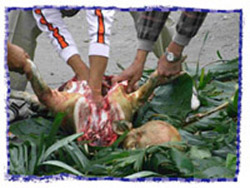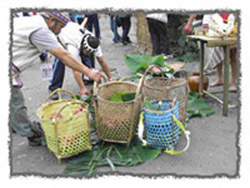|
 The
Meanings of the Sacrifices The
Meanings of the Sacrifices
Mgay Bari is the most
important activity of thanking gods in a year.
It must be prepared with great care, including
the sacrifices, in order to receive blessings
from ancestral spirits.
In the interview with Mr.
Kaji, he said the sacrifices are the harvest
after a year’s painstaking works. Offering
sacrifices in Mgay Bari is to offer such
assiduous spirit to the ancestral spirits, so
that they may bless the tribe with better
harvests in the coming year.
Mr. Kaji also told us that
once these sacrifices become sacrifices, they
come into contact with the ancestral spirits and
become holy. People other than priests will
incur bad luck if they touch these sacrifices.
So ordinary people are not allowed to touch the
sacrifices; only the priests will place them.
Therefore people in the past would hide the
sacrifices beneath the earth, in the garden, or
valley, so that nobody could touch them. But,
Mr. Kaji said, since nowadays people must be
frugal, and there is not much millet, the
sacrifices will be shared by the priests after
the ritual.
References:
1. An Interview with
the local cultural worker Mr. Kaji at Tonglan
Village in Shioulin Township, Hualien County, on
January 25, 2008.

 The
Ritual of Boar Butchering The
Ritual of Boar Butchering
In the Truku
conventions, boar butchering is an important
ritual. In the annual Mgay Bari, of course, the
Truku will hold such ritual for the ancestral
spirits. They will share the meat evenly to the
members, so that everyone can receive blessings
from the ancestral spirits.
In the interview with Mr.
En-ma, he mentioned that butchering a boar in
Mgay Bari is to let the ancestral spirits know
that we are praying to them.
The Truku ancestors in the
past had to thank the ancestral spirits before
they ate and drank. Before they ate, they would
hold a bit food and said, “Sus” to thank the
ancestral spirits. The same applied to drinking;
they would immerse their index finger in the
alcohol and spit a bit out saying “Sus”. In Mgay
Bari, The Truku would, symbolically, take a
piece of meat or just point forward and shout
“Sus Bari” to tell their ancestral spirit to eat
or to drink first.
Mr. En-ma also said that
placing a piece of meat as sacrifices to the
ancestral spirits is actually a way of healing,
for the purpose of praying for protection from
nightmare.
In the interview with Mr.
Kaji, he also mentioned that butchering a boar
is to request blessings from the ancestral
spirits. Boar meats and bloods must be shared by
everyone, so that they can receive the
blessings.
Therefore, Mr. Kaji said, the
one who distributes the meat must be good at
mathematics. He must first counted the numbers
of all family members, and each member must have
every parts of the boar, such as boar meat, boar
bones, viscera, legs, etc. Suppose a clan has
ten families; then each part of the boar must be
divided into ten portions and distribute to each
family. If a family does not get a portion of
boar leg, that family will come to the person
angrily and blame him. One must follow this rule
however many members there are.
 |
 |
|
A boar was put on a banana leaf for
distribution.
|
The boar was being cut into pieces
for distribution evenly. |
|
 |
|
Shared
boar meats were put into
baskets.
|
|
References:
1. An Interview with the
elder Mr. En-ma at Tonglan Village in Shioulin
Township, Hualien County, on January 4, 2008.
2. An Interview with the
local cultural worker Mr. Kaji at Tonglan
Village in Shioulin Township, Hualien County, on
January 25, 2008.

 Types
of Sacrifices Types
of Sacrifices
Sacrifices used in Mgay
Bari are usually the harvests of the Truku’s
assiduous farming, and hunting in the mountain.
In the interview with
Mr. Kaji, he said that the sacrifices are the
things we plant ourselves, such as:
millets,
maizes,
sweet potatoes,
taros,
etc. For course, chickens, ducks and pigs farmed
at home are indispensable. Besides these
sacrifices, as a hunting tribe, the Truku will
also offer prey such as
wild boar
to the ancestral spirits obtained from the
hunting just before the Ancestral Spirit Ritual.
References:
1. An
Interview with the local cultural worker Mr.
Kaji at Tonglan Village in Shioulin Township,
Hualien County, on January 25, 2008.

※
An Introduction to the Sacrifices in Mgay Bari
 Millets Millets
Truku name: masu
Scientific name:
Setaria italica (L.) P. Beauv.
Description:
It belongs to Poaceae family
and Setaria genus. It is an annual plant, with
straight stalk, and grows lushly. It has
string or lanceolate leaves; its ligule is a
circle of hair, sometimes with membranes. It is
cylindraceous panicle, looks like tassel or
tightened on branches, height 10-30 cm, drooping
when matured. Inner husk and its tassel are
equally long.
Taiwan millets have a long
history in cultivation. Perhaps they were
introduced by early migrant from mainland China.
They were the primary food for early Taiwan
indigenous people. Usually they were planted at
hillsides in spring. Currently, Pingtung County
and Taitung County have the largest production
of millets.
According to an investigation
by Taitung District
Agricultural Research and Extension Station,
Council of Agriculture, there was 160 varieties
of millets in Taiwan. In the past, “Puloyang”
and “Gaolan” in Taitung County, and Kuwali Yalin”,
“Lala”, and “Lukang” in Pingtung County has the
largest farming area of millets. These varieties
were inherited by the indigenous people from
various places. Their origins are unclear;
besides, due to their long history of
cultivation, these breeds have already been
mixed. After breeding units’ seed selection,
Taiwan has 8 breeds; among them, “Taitung 7” is
the most widely cultivated and promoted.
References:
1. A Short Record of
Taiwan Vascular Bundle Plants, Vol.
5—Millets.
http://subject.forest.gov.tw/species/vascular/5/index-1.htm
2. Lin, W.J. (1996)
Millets. A Handbook of the Cultivation of
Various and Small Amount of non-Rice and –Wheat
Products.. Agricultural and Forestry
Department, Taiwan Provincial Government.
3. Su, C.C. (2001) An
Introduction to Taiwan Delicate non-Rice and
–Wheat Products. non-Rice and –Wheat Products
and Livestock Products.
4. Agriculture and Food
Agency website—Millets.
http://www.afa.gov.tw/ public_index.asp?CatID=85

 Maizes Maizes
Truku
name: sqmu
Scientific
name: Zea mays L.
Description:
It belongs
to the Poaceae family and Zea genus. It is an
annual plant with straight stalks; it has
supporting roots at the base part of it stalk.
It has big and wide leaves, big ligule with
hairs. Male flowers grow at its top and are
cone-shape. Tassels are grow in pairs, one with
small stem, both have stamen; external husk are
papery. Female flowers axillary with single
raceme, which are wrapped by various bud; small
tassels grow from plump stems, and are dense.
They are cultivated, can only be seen beside
fields and farms.
Maize was
imported from Xifan (between Yunnan, Tibet, and
Myanmar) to China, earlier than other
American-originated plants. According to A
General Record of Yunnan in Ming Dynasty’s
Wanli period, “Records of Dali Area” records
that maize was already widely cultivated.
References:
1. A
Short Record of Taiwan Vascular Bundle Plants,
Vol. 5—Maize.
http://subject.forest.gov.tw/species/vascular/5/index-1.htm
2. Chiba,
T., trans. by Yu, J.R. “The Maize Recorded in
Ming’s Documents”. Scientific Agriculture,
1973: Vol. 21, Issue 5/6.
http://seed.agron.ntu.edu.tw/ cropsci/
maize/yu01.htm

 Sweet
Potatoes Sweet
Potatoes
Truku
name: bunga
Scientific
name: Ipomoea batatas (L.)
Lam.
Description:
It belongs
to the Convolvulaceae family and the Ipomoea
genus. It is crawling herbaceous vine, whose
stems crawl or entwine with the front end. Roots
grow at the ground touching stems. Its root
tubers are edible; leaves various greatly, and
are heart-shape or circular, 6-14 cm long. Its
base is heart-shape or truncate. Leafstalks are
4-15 cm long. It has pink to light blue flowers,
and bell or funnel shape; its fruits are
egg-shape.
Sweet
potatoes are originated in Latin American, and
were brought back to Spain by Columbus. They
were import to the Philippians in the 16th
century. According to the Nong-zheng-quan-shu
by Hsu Guang-chi, Min-xiao-hong by Chou
Liang-gong, and Min-zaji by Shih Hong-bao,
in Ming Wanli period, Chen Cheng-long from
Fukian brought back sweet potatoes vine to
Changchou, Fukien. They are important food in
Taiwan; they can be seen in flats and low-level
mountain regions fields anywhere on the island.
References:
1. Agriculture and Food Agency Website—Edible
Sweet Potatoes.
http://www. afa.
gov.tw/public_index.asp?CatID=77
2. A
Short Record of Taiwan Vascular Bundle Plants
, Vol. 4—Sweet Potatoes.
http://subject.forest.gov.tw/species/vascular/4/Book1/index-1.htm

 Taro Taro
Truku
name: sari
Scientific
name: Colocasia esculenta (L.)Schott
Description:
It
belongs to the Araceae family and Colocasia
genus. It is an herbaceous wet-grown plant. Its
Stem tubers are egg-shape, having brown and
rough skin, with several wheel loops, their
pulps are white, light yellow or purple dotted.
Its leaves are wide and almost circular shape or
shield shape, and grow on the top of the stems.
Leaves’ points are short and sharp or short and
gradually sharp. Its leafstalks are red-brown or
green, having red-brown bases. Its tubers and
leafstalks are edible. Its tubers contains
starch, fiber, adhesive egg white, potassium,
magnesium, calcium, phosphorous, zinc, and iron.
It
originated from South Eastern Asia, India and
South China area. It was imported to Taiwan by
Taiwan aborigine from South Eastern Asia, and
then later was imported from China and Japan.
Since its long history of cultivation, there are
many different breeds and varieties. In terms of
cultivation environment, Taros can be divided
into hydra taro and drought taro. Bin-lang-hsin-yu
and Mian-yu are the most common taros on the
market. The former has better taste and scent,
thus, popularity, while the latter is usually
processed as taro powder.
References:
1. The
Fragrance of Chiahsian Taro—The
Taro File—Breeds of
Taro. http:// librarywork.taiwanschoolnet.org/cyberfair2006/jxp1/index2a.htm
2. Hualien
District Agricultural Research and Extension
Station—Column of Production and Marketing
Squad—Agricultural Speciality.
http://www.hdais. gov.tw/10/農特產品/蔬菜/taro.pdf
3. Agriculture Website for Kids—Mita
Kaleidoscope—Organisms—Plants—Vegetables—Stem
Vegatables.
http://kids.coa.gov.tw/knowledge.php?type=view
&code=A13&id=taita_taita_20080123104914
4. A
Short Record of Taiwan Vascular Bundle Plants,
Vol. 5—Taro.
http://subject.forest.gov.tw/species/vascular/5/index-1.htm

 Wild
Boars Wild
Boars
Truku
name: bowyak
Scientific
name: Sus scrofa taivanus
Description:
Taiwan
Wild Boars are smaller than ordinary farm pigs.
Their length from mouth to anus is about 70~90
cm; their heads slightly protrude, with a thick
disk-shape front end with nostrils. They have
small eyes, delicate tails with hairs. Young
wild boars have brown-yellowish and black
strips, very lovely. When they grown up, they
become gray-black in colour. Their limbs are
short, each with four fingers. Male boars have
developed fangs, while female ones do not.
They are
night animal, and polyphagia; mainly eat young
leaves, tubers, juicy fruit or crops grown by
farmers. They will also dig roots of trees or
weeds; and lay on grasses to rest. They often
left cylindraceous beast track; life-span last
15~20 years. They appear in forest and twitch
grass area throughout Taiwan.
References:
1. Yangmingshan
National Park—Taiwan
Wild Boars
http://www.ymsnp.gov.tw/web/webpage.aspx?f=data_file/animal93/animal93_d3-12.htm
2. Digital
Museum of Zoology, National Taiwan University
—Mammal Database—Taiwan Wild Boars. http://archive.zo.ntu.edu.tw/mammal/r_mamm_index.asp?mamm_id=M0058

|
※
A Student’s Comment
Yan Wang:
The
most impressive thing for me is that, Mr. Kaji
introduced to us many sacrifices used by the
aborigines and their functions, such as wild
boar meats are for the consumption of gods,
their bones are for decoration, millets and
maize are also for the gods’ consumption.
I
think my fellow student responsible for taking
photos is very attentive, whose merits include:
successfully captured the targets; some photos
are quite good. But there are also demerits:
some photos are blurry, while some other
unclear…Mr. Kaji explains a lot about the
functions of the sacrificial tools to us. I had
had no idea about the functions of these
sacrifices, but after his explanation, all of my
questions disappeared!
|
[Text by
Yu-ling Wen, Pei-hsuan Hsu, Hui-yu Yan, Yan
Wang, Teacher Shu-jun Hua; photo by Meng-yuan
He, Yu-bo Wen, Teacher Shu-jun Hua; image
processing by Meng-yuan He, Wen-bin Hsu]

|